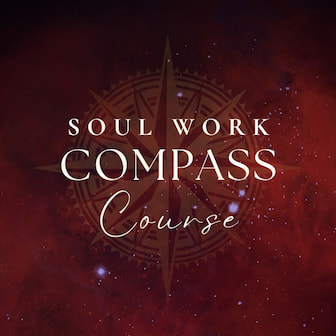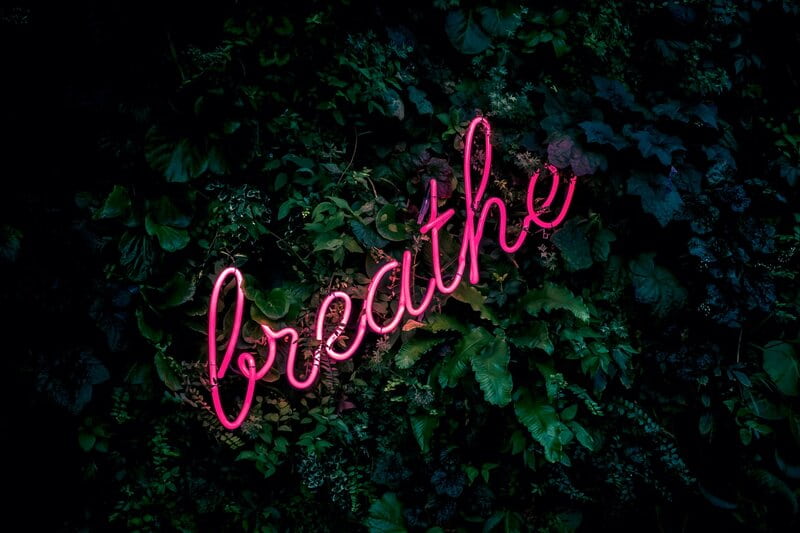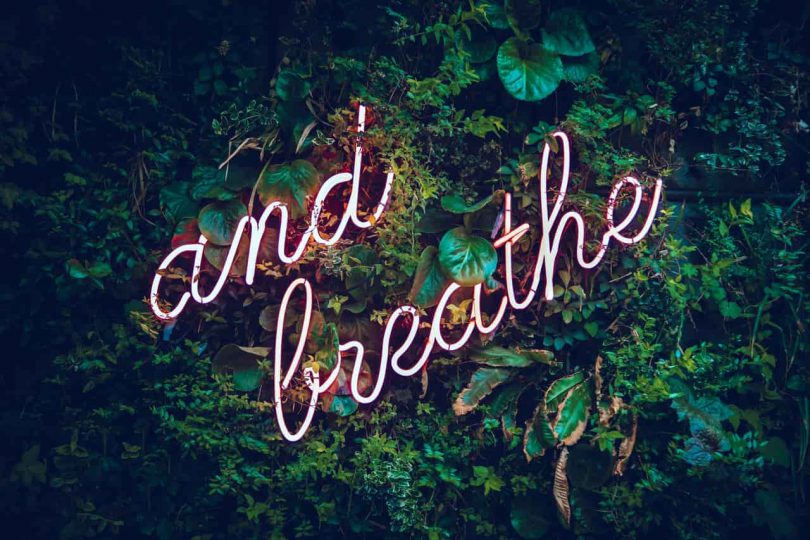Your breath is one of the most sacred, yet forgotten, parts of your daily existence.
As one of the few functions in the human body that is both conscious and unconscious, the breath is a conduit of life. It is the physical manifestation of your chi (qi), prana, or lifeforce energy. And you do it 23,000 times a day.
Most of all, your breath is always there for you, 24/7, until the day you die. It is there not only to help animate your body, but also to help it heal, purge old energy and toxins, and invite in whatever is new and invigorating.

Soul Work Compass Course:
Feeling lost or disconnected? The Soul Work Compass guides you through a 12-lesson alchemical journey to transform emptiness into clarity and deep self-insight. Create your personal compass to navigate life with clarity, freedom, and soul-aligned direction. Start your Great Work today!
Your breath is your most ancient friend and it is always there to call upon when you need help.
Isn’t that beautiful? Isn’t that comforting? Isn’t that magical?
Whenever you need a burst of fresh energy, breathe. Whenever you need to process heavy emotions, breathe. Whenever you need to calm down, breathe.
You have an anchor, a doorway into immediate meditation within you wherever you go and whatever you do – and that’s what’s so bewitching about breathwork. Breathwork simply takes this natural, primordial bodily function and makes a conscious practice out of it.
In this article, I’m going to explore a few different varieties of breathwork – and they all beautifully complement the inner work practices of self-love, inner child work, and shadow work that are needed for deepening the process of spiritual awakening.
Table of contents
What is Breathwork?

While ancient, ‘breathwork’ is a term that first originated in the 1970s, referring to the practice of consciously directing the breath. The goal of breathwork is to positively alter the body, mind, heart, or spirit and produce therapeutic inner transformation. There are numerous forms of breathwork in existence today. While some of them go right back to the old yogic practices of pranayama, others are relatively new such as the Wim Hof Method.
Benefits of Breathwork

Breathing is the fundamental unit of risk, the atom of inner courage that leads us into authentic living. With each breath, we practice opening, taking in, and releasing. Literally, the teacher is under our nose. When anxious, we simply have to remember to breathe.”
– Mark Nepo
There’s an overwhelmingly vast array of benefits associated with regularly practicing breathwork. While some are scientifically proven, others are waiting to be validated (yet are quite self-evident!). Here’s what you can expect to experience from making breathwork an everyday habit:

Shadow & Light Membership:
⭐️⭐️⭐️⭐️⭐ "Straight from the very first weekly email, this has been mind-blowingly powerful, the synchronicity and the on-vibe contents resonate uncannily with my soul’s current challenges." – Marie
- Relaxes your nervous system
- More calmness (and less anxiety/stress)
- More self-acceptance (and less depression)
- Enhances overall mental health
- Improves immune function (which means you stay healthy for longer)
- Alkalizes your blood and decreases inflammation in the body
- Enhances mental clarity and focus
- More energy and vitality
- Can result in a mystical experience or deep spiritual insights
- Boosts feelings of joy and happiness
- Aids creativity and intuition
- Enhances feelings of connection with others
- Increases mindfulness and appreciation of life
On a side note, some breathwork practices also have mind-altering effects (in other words, they get you high!), which many people find enjoyable.
In fact, the term ‘breathwork’ rose in popularity in the 1960’s-70’s mostly thanks to LSD researchers Dr. Stanislav and Christina Grof who created their Holotropic Breathwork model thanks to their findings.
Breathwork & Spiritual Awakening

You might be wondering what on earth your breath has to do with spiritual awakening, but my response is how isn’t the breath related to your spiritual path?!
The word ‘spirit’ itself derives from the Latin word spiritus which literally translates to “breathing; breath; breath of a god” (1). There are also other connections between breath and spirit in many other languages as well such as Hebrew (ruach meaning “spirit, breath, wind, and/or mind”) and Greek (pneuma meaning “air, soul, breath”).
So here we can see that breath and spirit are inextricably linked – and as such, breathwork is a powerful and fundamental practice on our spiritual awakening journeys.
Learning to consciously work with our breath, whether through meditation, yoga, nature bathing, or simple mindfulness practices can help us to bridge the gap between the mind and heart, body and soul.
By tuning into the sacred cycles of the in-and-out breath, we learn about the rhythms of life, our mental states, and how to arrive fully and completely in the present moment. The breath heals us, awakens us, still us, and reveals to us our True Nature.
Warning

Before we dive deeper into this topic, I want to issue a warning.
Breathwork, for some people, particularly those with pre-existing heart problems, can be dangerous. It’s best to speak to a qualified medical practitioner before attempting any form of breathwork, particularly if your health is fragile.
Pregnant women should also seek professional advice first. Furthermore, some forms of breathwork are best practiced with a qualified practitioner, such as Holotropic and Rebirthing breathwork.
Would you like to save this?
Your information will never be shared.
Above all, if you feel intense discomfort or feelings of unsafety during this practice (either by yourself or with another person), stop immediately. The beauty of breathwork is that you can stop at any time, and indeed you should stop if at any point it becomes too much for you.
5 (Intensely Transformative) Types of Breathwork

Where to start? There are many varieties of breathwork that can aid your spiritual healing and growth, and below I’ll summarize them:
1. Pranayama
Arguably the oldest form of ‘breathwork’ there is, pranayama (a Sanskrit word that translates to “breath control”) is a series of yogic breathing techniques that are designed to liberate the flow of prana (life force energy) and increase spiritual self-realization.
Pranayama can either be practiced alongside yoga asanas (poses) or by itself. There are eight types of pranayama with dozens of individual methods described in the Vedas (or ancient Indian religious texts). Some of the more common ones are Skull Shining Breath (or Kapalabhati), Alternate Nostril Breathing (or Nadi Shodhan), and Conqueror Breath (or Ujjayi).
2. Holotropic breathwork

Created by transpersonal Czech psychiatrists Stanislav and Christina Grof, holotropic breathwork was created in the 1970s as a way of helping people to experience deep inner healing and transformation.
After studying and experiencing the therapeutic effects of the drug LSD, the Grof’s developed their holotropic model after the ban of this psychedelic drug in the 1960s. The intention was to design an experience that was similar to LSD with its mind-altered effects but without the side effects (and legal issues).
Holotropic breathwork is often practiced alongside the rhythm of primal music, with participants breathing rapidly under instruction for up to two hours or more. Afterward, the practice is accompanied by drawing mandalas and discussing what happened.
Holotropic breathwork is a breathing technique that must be practiced with a qualified practitioner – so please be wary of trying it by yourself (having a safe holding space is important). The ultimate goal is to access higher states of consciousness and connect with the Soul.
3. Rebirthing breathwork
Rebirthing breathwork is a breathing technique that was developed by visionary Leonard Orr in the 1970s. Orr reported having re-lived his own birth in a bathtub, which is what inspired him to devise this method.
The goal of this technique is to connect you with the subconscious mind, release traumatic childhood memories, and experience a kind of invigorating ‘rebirth’ (hence the name).
Rebirthing breathwork utilizes a circular breathing technique alongside the guidance of a trained facilitator. Some forms of rebirthing are conducted in a bathtub to mimic the process of being born (or reborn in this case). Such a practice can be a powerful inner child work practice that can enable you to heal and empower the wounded inner child we all carry.
4. Shamanic breathwork

Shamanic breathwork is a modern adaptation of old circular breathing techniques with the purpose of getting a person in touch with their inner healer (shaman). Such a practice was developed primarily by visionary teacher and shaman Linda Star Wolf in the 1990s.
During a shamanic breathwork experience, participants begin by smudging, chanting, and setting an intention. They then breathe rhythmically to primal music (such as the sound of drums), with some practitioners incorporating chakra healing, spirit animal contact, and other practices into the breathwork session.
Other than connecting with your inner shaman, shamanic breathwork’s aim is to help you experience more wholeness, healing, and inner guidance.
5. Wim Hof breathwork
A relatively new technique (although based on ancient pranayama methods), the Wim Hof method was developed by Dutch extreme athlete Wim Hof – also known as “The Iceman.”
Hof earned his nickname thanks to a series of intense physical feats, such as being able to withstand freezing cold temperatures and ice baths for prolonged periods of time.
His method involves three central pillars: exposure to cold, breathing (controlled hyperventilation), and meditation. The breathwork part of his method involves taking thirty power breaths and then after that, taking a deep inhale and retaining your breath as long as comfortable, then exhaling. Afterward, one must inhale deeply for another 10-15 seconds, retain, and then exhale.
This breathwork process is then repeated for up to three more rounds. The Wim Hof method is aimed toward increasing physical and mental wellbeing and has been scientifically linked to a number of benefits.
Other forms of breathwork include:
- Vivation
- Integrative breathwork
- Transformational breathwork
- Biodynamic breathwork
- Clarity breathwork
- Zen Yoga Breathwork
If I’ve missed out on any let me know in the comments!
Breathwork and Spiritual Healing

Deep, slow, and intentional breaths, that expand and contract the belly, allow for more oxygen to enter the body … When this respiration is consistent, unnecessary tension will not build up in the body or in the mind. When the body and mind are free from allocating energy to unnecessary tension, that energy can be more directly utilized in the process of emotive-psychosynthesis. Deep breathing is the tool of the masters for letting go of old attachments and old emotions and for extracting the wisdom hidden within the experiences of life.
– Ron Teeguarden
As we’ve seen, breathwork can help us on a physical, mental, emotional, and even spiritual level – it’s an immensely powerful healing modality!
What’s essential is setting an intention beforehand. Without a clear intention, it can be difficult to appreciate (and sometimes notice) the benefits and changes brought about by breathwork.
Think about what issue you’re facing in life the most right now. Perhaps the issue is a physical illness. Breathwork can help you with that, but it can also go to the deeper roots of that issue that are often spiritual in nature. (See our article on soul loss for more information.)
By creating a drug-free altered state of consciousness, breathwork helps us to access the realm of our Souls and dip into the ethereal world of Spirit. Some of the greatest discoveries, epiphanies, and breakthroughs you can ever make might be through a breathwork session.
What’s important is that you choose a form of breathwork that resonates with you – this is what will make the process deep and impactful.
By helping us to release deep layers of pain, trauma, and repressed emotion, breathwork liberates energy within us – energy to heal, to transform, and to connect with our True Nature.
Download FREE Breathwork Worksheets!
Go deeper with a breathwork journaling prompt + printable meditation mandala!
6 Easy Breathwork Practices That You Can Practice Alone

The flow of breath plays a large part in determining the overall health of a person, and especially their ability to feel alive, vital, and to express spontaneously.
– R. Johnson
For most of the above breathwork practices, you need a qualified practitioner to help facilitate the process (it’s safer and more effective that way). But understandably, not everyone has time or money to find a breathwork facilitator.
Thankfully there are some gentle but transformative breathwork techniques out there that you can practice alone (or with a friend).
Please note, however, that everyone is different, and some people might find the following techniques too intense. Listen to your body, and if at any point you feel overwhelmed by strong emotions or physical sensations, stop.
Below we’ll explore some simple forms of breathwork that you can (usually) practice by yourself:
1. Alternate Nostril Breathing (a pranayama technique)
Also known as Nadi Shodhana, alternate nostril breathing is an ancient yogic breathwork technique that helps you to calm down and find inner peace. This practice is particularly helpful to those who suffer from chronic stress, anxiety, ungroundedness, or insomnia.
Alternate nostril breathing is also said to enhance mental focus, remove toxins from the body, balance the right and left hemispheres of the brain, and clear the energy channels within the body.
Here is an instructional video:
2. The 4-7-8 Relaxing Breath
This simple practice is perfect for when you’re short on time. It helps you to connect with your body, be present with your emotions, and unwind your nervous system. The basic premise is to breathe in for a count of four, hold four a count of seven, and exhale for a count of eight.
This video will give you an idea of how to practice 4-7-8 breathing:
3. Soft Belly Breathing
In the modern world, a large percentage of us breathe from our chests, not from our abdomen. Unfortunately, this incessant chest-breathing increases stress, nervous tension, and a racing mind that never seems to calm down.
Learning how the belly breath is vital if we are to find our inner center. But frustratingly, those who encourage belly breathing often forget one vital thing: it has to be soft and unforced. Ironically, when we force the belly breath, the result is a feeling of increased anxiety.
As author and breathing practitioner Patrick McKeown writes:
Unlike many modern Western teachers of yoga, who instruct students to breathe hard in order to remove toxins from the body, authentic teachers know that when it comes to breathing, less is more. The traditional Chinese practice of Taoism succinctly describes ideal breathing as ‘so smooth that the fine hairs within the nostrils remain motionless’. True health and inner peace occurs when breathing is quiet, effortless, soft, through the nose, abdominal, rhythmic and gently paused on the exhale. This is how human beings naturally breathed until modern life changed everything.
Therefore, the goal with soft belly breathing isn’t to force any breath, but instead allow the breath to become soft, deep, and abdominal.
This video might help you begin a belly breathing practice:
4. Circular Breathing
Circular breathing (not to be confused with circular musician breathing) needs to be approached gently and mindfully, especially as it’s often used as a consciousness-altering technique.
When we circular breathe, we take a gentle breath in and out without pausing. This is a practice that can be done quietly or out loud (that is, making a noise when breathing out).
As a breathwork technique, circular breathing can release old emotions, cleanse the energetic and emotional body, and even open up the mind to deep spiritual insights.
Here is an instructional video:
5. Visualization Breathing
There are endless forms of visualization that we can use in conjunction with deep breathing – and that’s what makes this breathwork practice so eclectic and adaptable.

Overwhelmed by where to begin?
The Alchemical Soul Work Workbook is your map and compass. It takes the guesswork out of deep inner work, empowering you with a step-by-step process to confidently find clarity and alignment with your true Self.
Visualization breathing can be uniquely tailored to your needs in the moment; all you need is your breath and creative imagination.
Some common forms of visualization breathing are:
- Visualizing light washing through your body as you inhale and exhale
- Visualizing each of your seven chakras glowing as you breathe into them
- Visualizing air moving through your respiratory system
- Visualizing all stress and illness leaving your body as you exhale
- Breathing in light, breathing out darkness
- Breathing in pain, and breathing out loving-kindness (this is known as the ‘Tonglen’ Buddhist practice)
This video might inspire you:
6. Square Breathing
Square breathing is a wonderfully simple practice and is great for those who struggle to memorize breathing techniques. (It’s also great for kids!)
To do square breathing, simply breathe in for the count of four, hold for the count of four, and exhale for the count of four (4-4-4). You can also visualize forming a square in your mind while doing this breathwork practice if it helps.
In this video, square breathing is explained (instruction starts at 1:06)
This simple breathwork practice helps to ground and center the body and mind. It can also be used before (or during) meditation practice and as a mindfulness technique.
Takeaway
Breathwork is a powerful practice that can accompany you anytime, anywhere, on your life path – quite simply, it works like magic because practically anyone can do it!
Not only is breathwork freely accessible and gloriously straightforward (in most cases), but its ability to aid spiritual healing, growth, and transformation makes it powerfully healing and cleansing.
To start your journey with breathwork, choose one of the above practices (that you can do alone) and dedicate just 2-5 minutes each day to it. To make a solid habit, it’s a good idea to set a regular time, such as in the morning or just before bed. (If you struggle to remember, set a reminder on your phone or calendar!)
If you want to experience the benefits of breathwork firsthand, right now, watch the video below. It’s one of my favorite calming visuals that helps to guide the breath and slow it down almost instantaneously:
What is your favorite breathwork practice and why? I’d love to hear in the comments. Also, if you’ve had any amazing or mind-blowing experiences while doing breathwork, please share in the comments about that as well! I’d love to hear. :)
If you need more help, we offer 2 powerful ways to guide you on your inner journey:
1. The Soul Work Compass Course: Break free from feeling lost and disconnected. The Soul Work Compass is a practical 12-step course that transforms soul loss into soul clarity. Discover your core values, heal core wounds, and create a personalized compass to guide every decision you make.
2. The Inner Work Journal Bundle: Heal at the root. This Inner Work Journal Bundle guides you through self-love, inner child healing, and shadow integration with 150+ prompts and activities. You get editable digital files to use on any device or print unlimited times. Not for lukewarm seekers, these journals are for those ready to transform.



 $3
$3




Box Breathing, Nadi Shodhana, and Kapalabhati are my three favorite types of breathwork.
Just thought I’d add some mindfulness quotes, if you find that you’re stuck in these meditation practices, just to add extra hints. (Look up “Mindfulness quotes,” or “Meditation quotes,” for more insight if you wish, whenever you’re stuck, and take time to think about it or journal about it.) 1. “If someone comes along and shoots an arrow into your heart, it’s fruitless to stand there and yell at the person. It would be much better to turn your attention to the fact that there’s an arrow in your heart…” ― Pema Chödrön, Start Where You Are: A Guide to Compassionate Living 2. “Things falling apart is a kind of testing and also a kind of healing. We think that the point is to pass the test or to overcome the problem, but the truth is that things don’t really get solved. They come together and they fall apart. Then they come together again and fall apart again. It’s just like that. The healing comes from letting there be room for all of this to happen: room for grief, for relief, for misery, for joy.” ― Pema Chödrön, When Things Fall Apart: Heart Advice for Difficult Times 3. “People usually consider walking on water or in thin air a miracle. But I think the real miracle is not to walk either on water or in thin air, but to walk on earth. Every day we are engaged in a miracle which we don’t even recognize: a blue sky, white clouds, green leaves, the black, curious eyes of a child—our own two eyes. All is a miracle.” ― Thich Nhat Hanh, The Miracle of Mindfulness: An Introduction to the Practice of Meditation 4. “In meditation we discover our inherent restlessness. Sometimes we get up and leave. Sometimes we sit there but our bodies wiggle and squirm and our minds go far away. This can be so uncomfortable that we feel’s it’s impossible to stay. Yet this feeling can teach us not just about ourselves but what it is to be human…we really don’t want to stay with the nakedness of our present experience. It goes against the grain to stay present. These are the times when only gentleness and a sense of humor can give us the strength to settle down…so whenever we wander off, we gently encourage ourselves to “stay” and settle down. Are we experiencing restlessness? Stay! Are fear and loathing out of control? Stay! Aching knees and throbbing back? Stay! What’s for lunch? Stay! I can’t stand this another minute! Stay!” ― Pema Chödrön, The Places That Scare You: A Guide to Fearlessness in Difficult Times 5.“We have negative mental habits that come up over and over again. One of the most significant negative habits we should be aware of is that of constantly allowing our mind to run off into the future. Perhaps we got this from our parents. Carried away by our worries, we’re unable to live fully and happily in the present. Deep down, we believe we can’t really be happy just yet—that we still have a few more boxes to be checked off before we can really enjoy life. We speculate, dream, strategize, and plan for these “conditions of happiness” we want to have in the future; and we continually chase after that future, even while we sleep. We may have fears about the future because we don’t know how it’s going to turn out, and these worries and anxieties keep us from enjoying being here now.” ― Thich Nhat Hanh, Peace Is Every Breath: A Practice for Our Busy Lives
Hi,
when it comes to various breathing techniques, you said ( and I copy the following):
but should you not breathe in loving kindness and breathe out the pain?
Tonglen is a type of meditation where you breathe in the pain of others, and breathe out loving kindness to the world. It’s one of those metta meditations (focused on developing empathy), such as loving kindness meditation (basic empathy practice) , compassion meditation (focused on empathizing with people’s negative feelings), celebratory joy meditation (focused on celebrating people’s positive feelings, rather than feeling envy), or equanimity meditation (developing a balance of all these). Though if you find breathing in loving kindness and breathing out the pain more helpful to focus on self-love meditation (another type of metta meditation), go ahead. To find equanimity, you need a balance throughout all these after all, and if you find you’re too focused on the negative feelings of others, try to find gratitude in what good things others find in their life, such as in celebratory joy meditation or mudita meditation.
Wow didn’t know that one is called square breathing, I do that everyday!
Woohoo, now you have a name for it!
I never knew there were so many health-benefits to breathing, so this article was very insightful!
Although breathwork is something I’ve neglected and need to do more often, I enjoy the (when I actually take the time to do it “just slowing down-and relaxation-deep breathing”, and this is because it feels quite grounding and releaxing.
Yes, it is truly astounding how many health benefits there are with something so simple and fundamental as breathing! I find that creating a habit (a little slice of the day) helps to get the most out of breathwork. Thanks for reading and being here Janni ♡
This article came at a great time. Over the past few weeks I have been intuitively focusing on my breath and have been feeling more connected to myself every time I practiced breathing deeper. I found myself deep breathing for about 5 minutes the other night and went into an altered state. I lost track of time and felt so renewed afterwards. It left me very curious. I’m going to make this a practice. Thank you for leaving the links!
It’s so simple yet so inwardly rejuvenating isn’t it Max!? Our breath, to me, is one of the greatest paradoxes in life — it’s so simple yet so deep in its ability to transform us on literally every layer of our being (from the cellular to the spiritual and beyond). Thank you for sharing the basic but powerful truth that our breath reconnects us to ourselves!
Good, wonderful work. But as a black man I don’t understand the most easy , quick and practical process I can emerge this spiritual realization? Please is there any medicine I can drink or any special prayer process for me.
Hi Isah, thanks for commenting. Would you mind explaining what you mean by “special medicine you can drink” and “special prayer process.” I’m not sure what religion (or not) you identify with, but the breath can be mindfully used by anyone of any race, gender, religion, etc. :)
It is great to read and find within some clear YouTube examples on Breathing techniques to tackle Existential Depression and other maladies which inhibit Spiritual Development and growth. So thanks for the experiences and knowledge you both share as it is very much needed in these tough times. Namaste
It is a pleasure to be of service John! I’d be curious to hear how your experience with any of breathing practices goes. :)
Wonderful article! Informative and motivating. Thank you for doing the research and sharing things that we can do on our own and things to go deeper. I also appreciate the comments. I learn from everyone! Thank you!
Hi
Thank you so much for your all great points,
I’m a Yoga Instructur, I’m doing meditation and breathwork from 2 years now, and I have classes for them too, Recently I had an exprience in the middle of my breathing practic, after 15 mins, suddenly I went from back, for about maybe 5 to 10 second, with a little shake and vibration, and when I came up, I just didn’t know where am I and And what happened, It seems like I was wake up from the deep and long long sleep, I am curious what was that, It was so wierd and overwhelming, I also have video from that time when I fell, I will be happy if help me to know more about that,
❤️
Hi Sam, thank you for sharing your experience. That must have been quite alarming for you! When I hear ‘shake and vibration’ the force of kundalini energy (https://lonerwolf.com/kundalini-awakening/) immediately comes to mind, however, I can’t speak for your experience. Have you tried journaling / meditating on it? If you keep having experiences such as this, I’d advise toning them down and doing less as you might be overwhelming your nervous system. Take care of yourself ♡